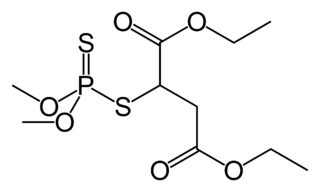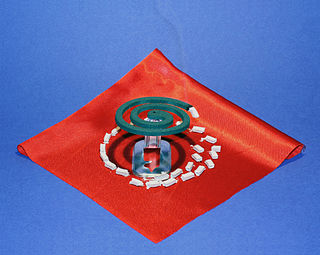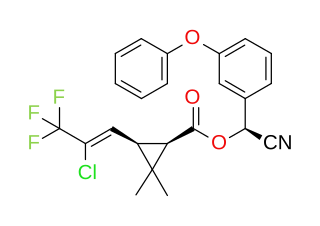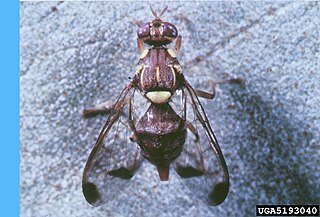Related Research Articles

Pesticides are substances that are meant to control pests. This includes herbicide, insecticide, nematicide, molluscicide, piscicide, avicide, rodenticide, bactericide, insect repellent, animal repellent, microbicide, fungicide, and lampricide. The most common of these are herbicides, which account for approximately 50% of all pesticide use globally. Most pesticides are intended to serve as plant protection products, which in general, protect plants from weeds, fungi, or insects. As an example, the fungus Alternaria solani is used to combat the aquatic weed Salvinia.

Insecticides are pesticides used to kill insects. They include ovicides and larvicides used against insect eggs and larvae, respectively. Insecticides are used in agriculture, medicine, industry and by consumers. Insecticides are claimed to be a major factor behind the increase in the 20th-century's agricultural productivity. Nearly all insecticides have the potential to significantly alter ecosystems; many are toxic to humans and/or animals; some become concentrated as they spread along the food chain.

Piperonyl butoxide (PBO) is a pale yellow to light brown liquid organic compound used as a synergist component of pesticide formulations. That is, despite having no pesticidal activity of its own, it enhances the potency of certain pesticides such as carbamates, pyrethrins, pyrethroids, and rotenone. It is a semisynthetic derivative of safrole.

N,N-Diethyl-meta-toluamide, also called diethyltoluamide or DEET, is the most common active ingredient in insect repellents. It is a slightly yellow oil intended to be applied to the skin or to clothing and provides protection against mosquitoes, flies, ticks, fleas, chiggers, leeches and many biting insects.

The pyrethrins are a class of organic compounds normally derived from Chrysanthemum cinerariifolium that have potent insecticidal activity by targeting the nervous systems of insects. Pyrethrin naturally occurs in chrysanthemum flowers and is often considered an organic insecticide when it is not combined with piperonyl butoxide or other synthetic adjuvants. Their insecticidal and insect-repellent properties have been known and used for thousands of years.
Fly spray is a chemical insecticide that comes in an aerosol can that is sprayed into the air to kill flies. Fly sprays will kill various insects such as house flies and wasps.

Bifenthrin is a pyrethroid insecticide. It is widely used against ant infestations.

Malathion is an organophosphate insecticide which acts as an acetylcholinesterase inhibitor. In the USSR, it was known as carbophos, in New Zealand and Australia as maldison and in South Africa as mercaptothion.

Pest control is the regulation or management of a species defined as a pest; such as any animal, plant or fungus that impacts adversely on human activities or environment. The human response depends on the importance of the damage done and will range from tolerance, through deterrence and management, to attempts to completely eradicate the pest. Pest control measures may be performed as part of an integrated pest management strategy.

An insect repellent is a substance applied to the skin, clothing, or other surfaces to discourage insects from landing or climbing on that surface. Insect repellents help prevent and control the outbreak of insect-borne diseases such as malaria, Lyme disease, dengue fever, bubonic plague, river blindness, and West Nile fever. Pest animals commonly serving as vectors for disease include insects such as flea, fly, and mosquito; and ticks (arachnids).

Chlorfenapyr is a pesticide, and specifically a pro-insecticide, derived from a class of microbially produced compounds known as halogenated pyrroles.

Dimethoate is a widely used organophosphate insecticide and acaricide. It was patented and introduced in the 1950s by American Cyanamid. Like other organophosphates, dimethoate is an acetylcholinesterase inhibitor which disables cholinesterase, an enzyme essential for central nervous system function. It acts both by contact and through ingestion. It is readily absorbed and distributed throughout plant tissues, and is degraded relatively rapidly.

Haematobia irritans, the horn fly, is a small fly. It was first described by Carl Linnaeus in his 1758 10th edition of Systema Naturae. It is of the genus Haematobia which is the European genus of bloodsucking flies. Haematobia irritans is a native of Europe but has been introduced to North America and is considered a potentially dangerous livestock pest.

Chemtura Corporation was a global corporation headquartered in Philadelphia, Pennsylvania, with its other principal executive office in Middlebury, Connecticut. Merged into Lanxess in 2017, the company focused on specialty chemicals for various industrial sectors, and these were transportation, energy, and electronics. Chemtura operated manufacturing plants in 11 countries. Its primary markets were industrial manufacturing customers. The corporation employed approximately 2500 people for research, manufacturing, logistics, sales and administration. Operations were located in North America, Latin America, Europe and Asia. In addition, the company had significant joint ventures primarily in the United States. For the year ended December 31, 2015, the company's global core segment revenue was $1.61 billion. Chief executive officer was Craig A. Rogerson, who was also the president and chairman of the board of Chemtura Corporation. On April 21, 2017, Chemtura was acquired by the German chemical company Lanxess.

Bendiocarb is an acutely toxic carbamate insecticide used in public health and agriculture and is effective against a wide range of nuisance and disease vector insects. Many bendiocarb products are or were sold under the tradenames "Ficam" and "Turcam."

Cyhalothrin is the ISO common name for an organic compound that, in specific isomeric forms, is used as a pesticide. It is a pyrethroid, a class of synthetic insecticides that mimic the structure and properties of the naturally occurring insecticide pyrethrin which is present in the flowers of Chrysanthemum cinerariifolium. Pyrethroids such as cyhalothrin are often preferred as an active ingredient in agricultural insecticides because they are more cost-effective and longer acting than natural pyrethrins. λ-and γ-cyhalothrin are now used to control insects and spider mites in crops including cotton, cereals, potatoes and vegetables.

Bactrocera cucurbitae, the melon fly, is a fruit fly of the family Tephritidae. It is a serious agricultural pest, particularly in Hawaii.

Diflubenzuron is an insecticide of the benzoylurea class. It is used in forest management and on field crops to selectively control insect pests, particularly forest tent caterpillar moths, boll weevils, gypsy moths, and other types of moths. It is a widely used larvicide in India for control of mosquito larvae by public health authorities. Diflubenzuron is approved by the WHO Pesticide Evaluation Scheme.

Metofluthrin is a pyrethroid used as an insect repellent. The vapors of metofluthrin are highly effective and capable of repelling up to 97% of mosquitoes in field tests. Metofluthrin is used in a variety of consumer products, called emanators, for indoor and outdoor use. These products produce a vapor that protects an individual or area. Effectiveness is reduced by air movement. Metofluthrin is neurotoxic, and is not meant to be applied directly to human skin.

Sulfoxaflor, also marketed as Isoclast, is a systemic insecticide that acts as an insect neurotoxin. A pyridine and a trifluoromethyl compound, it is a member of a class of chemicals called sulfoximines, which act on the central nervous system of insects.
References
- 1 2 Uniroyal Chemical: EPA product sheet for Vigilante, 2001-09-27
- 1 2 Kydonieus, Agis F. (2017-10-02). Treatise on Controlled Drug Delivery: Fundamentals-optimization-applications. Routledge. ISBN 9781351406871.
- ↑ Insecticide and Acaricide Tests. Entomological Society of America. 1990.
- ↑ Miscellaneous Publications of the Entomological Society of America. The Society. 1988.
- ↑ Chemtura: EPA product sheet for Vigilante. 2013-02-04
- ↑ Poore, Matt (2012-06-12). "Practical Fly Control" (PDF). Center for Environmental Farming Systems. Retrieved 2018-01-08.